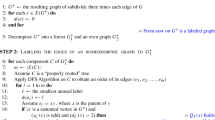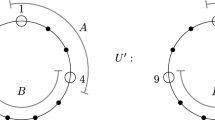Abstract
Let G be a graph without isolated vertices. The total domination number of G is the minimum number of vertices that can dominate all vertices in G, and the paired domination number of G is the minimum number of vertices in a dominating set whose induced subgraph contains a perfect matching. This paper determines the total domination number and the paired domination number of the toroidal meshes, i.e., the Cartesian product of two cycles C n and C m for any n≥3 and m∈{3,4}, and gives some upper bounds for n,m≥5.




Similar content being viewed by others
References
Brešar B, Henning MA, Rall DF (2005) Paired-domination of Cartesian products of graphs and rainbow domination. Electron Notes Discrete Math 22:233–237
Brešar B, Henning MA, Rall DF (2007) Paired-domination of Cartesian products of graphs. Util Math 73:255–266
Cockayne EJ, Dawes RM, Hedetniemi ST (1980) Total domination in graphs. Networks 10:211–219
Dejter IJ, Serra O (2003) Efficient dominating sets in Cayley graphs. Discrete Appl Math 129:319–328
El-Zahar M, Gravier S, Klobucar A (2008) On the total domination number of cross products of graphs. Discrete Math 308:2025–2029
Gavlas H, Schultz K (2002) Efficient open domination. Electron Notes Discrete Math 11:681–691
Gravier S (2002) Total domination number of grid graphs. Discrete Appl Math 121:119–128
Henning MA (2009) A survey of selected recent results on total domination in graphs. Discrete Math 309(1):32–63
Haynes TW, Slater PJ (1995) Paired-domination and the paired-domatic number. Congr Numer 109:65–72
Haynes TW, Slater PJ (1998) Paired-domination in graphs. Networks 32:199–206
Huang J, Xu J-M (2008) The bondage numbers and efficient dominations of vertex-transitive graphs. Discrete Math 308(4):571–582
Haynes TW, Hedetniemi ST, Slater PJ (1998a) Fundamentals of domination in graphs. Dekker, New York
Haynes TW, Hedetniemi ST, Slater PJ (eds) (1998b) Domination in graphs: advanced topics. Dekker, New York
Klavžar S, Seifter N (1995) Dominating Cartesian products of cycles. Discrete Appl Math 59:129–136
Pfaff J, Laskar RC, Hedetniemi ST (1983) NP-completeness of total and connected domination and irredundance for bipartite graphs. Technical Report 428, Clemson University, Dept Math Sciences
Proffitt KE, Haynes TW, Slater PJ (2001) Paired-domination in grid graphs. Congr Numer 150:161–172
Rall DF (2005) Total domination in categorical products of graphs. Discuss Math, Graph Theory 25:35–44
Xu J-M (2003) Theory and application of graphs. Kluwer Academic, Dordrecht
Acknowledgements
The authors would like to express their gratitude to the anonymous referees for their critical commons and helpful suggestions on the original manuscript, and for providing us Ref. (Brešar et al. 2007), which resulted in this version.
Author information
Authors and Affiliations
Corresponding author
Additional information
The work was supported by NNSF of China (No. 11071233).
Rights and permissions
About this article
Cite this article
Hu, FT., Xu, JM. Total and paired domination numbers of toroidal meshes. J Comb Optim 27, 369–378 (2014). https://doi.org/10.1007/s10878-012-9519-2
Published:
Issue Date:
DOI: https://doi.org/10.1007/s10878-012-9519-2




